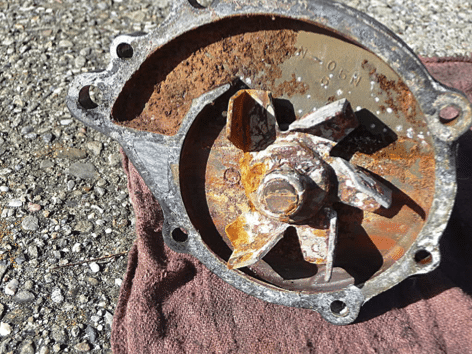by Collyn Rivers
Electrolysis Corrosion in Vehicles
Electrolysis corrosion in vehicles eats away your engine’s and cooling system parts such as water pumps. It is often caused by a faulty earthing lead. These are often accidentally disconnected, or broken. If so, return current travels through components such as the radiator cooling system. Also, via metal around them. This corrodes parts that have dissimilar metals.
This article explains the causes of electrolysis corrosion in vehicles. It shows how to detect it. And how to prevent it from happening.

Corroded water pump. Pic: Hybridz.org
Causes of Electrolysis
Electrolysis is common if anything electrical is self-fitted. This particularly so if near the engine/transmission. It is also common in vehicles with owner-fitted spotlights. These often use a radiator bracket for an earth return. It also common where electric radiator fans are incorrectly wired.
Where electrolysis is rife is with 4WDs with winches. These draw almost starter motor current. They must be earthed to the vehicle’s chassis. Or preferably directly to battery negative. Electrolysis corrosion in vehicles is, however, lessening. This is because it’s hard for owners to work on recently-made vehicles.
Electrolysis corrosion issues can be hard to resolve. Few repairers know how to fix it. The main cause, however, is poorly fitting earth leads. And also metal bonding straps. Or earth leads omitted following repairs.
Coolant changes
Electron flow through unintended paths may corrode anything metallic. By far the most common damage is via soldered radiator cores. Also, anything metallic through which coolant flows. It may also rust iron components. That, in turn, contaminates coolant. It also blocks cooling and heating systems.
Top-quality coolant is essential for today’s engines. They are designed to run hotter than before. Coolants thus have a boiling point higher than plain water. They also contain ingredients that discourage current flow.
You not only need high-quality coolant. It needs also to be at the correct concentration. That is usually 50%. The coolant gradually loses its effectiveness. It needs replacing every three years. Check using pH testing strips. Replace if under 7.0 pH.
Electrolytic corrosion in vehicles is also caused by using rain-water. Much now contains acid fallout.
How to check electrolysis corrosion
The motor industry has no agreed acceptable level of electrolysis. Most vehicles, however, have some. It is, however, easy to self-check. Top-quality coolant is essential for today’s engines. They are designed to run hotter than before. Coolants thus have a boiling point higher than plain water. They also contain ingredients that discourage current flow.
You can readily self-check the electrolysis level and also pin-point its source. That needed to do is a basic multimeter.
Switch the multimeter to an approximately 0-1.0 volt dc range. Connect its negative probe securely to battery negative. Insert the positive probe into the header tank’s coolant. Ensure it only touches the coolant. It must not touch anything metallic.
With the ignition off you are likely to see 0.5-0.7 volt. This is a surface charge. Leave the probe in the coolant. That voltage should drop back after a couple of minutes. Wait until it settles. If it doesn’t, ensure the radio is not turned on. Or a GPS unit or mobile phone etc connected.
Next, with the ignition off, connect a heavy jumper lead to battery negative. Connect the other end to the earth lead of anything electrical that’s been added. Or earth leads that have been removed/replaced. If the voltage drops, you’ve located the faulty lead. Fix or replace it. See what the meter reads now. There’s likely to be more than one such faulty lead.
Next, run the engine briefly. Check (as above) for leakage in charging circuits. If a fault voltage shows up then look for it as above. Check the alternator earthing lead etc.
Then, with the ignition off, turn on everything electrical. Especially spot-lights and every ancillary device. Check the meter again. If still excess, locate the cause by progressively switching things off.
The reason for testing as above
It is not feasible to test for just one leakage path at a time. There may be several. A single one may be insignificant. Collectively, however, leakage can be excessive.
Be aware that doing the above requires a well-charged battery.
Corrosion damage occurs above 0.5 volts for cast iron engines. It occurs above 0.15 volt for alloy engines. Be concerned if it exceeds 0.3 volts and 0.10 volts respectively.

Checking electrolysis. It can be done with a special test meter – or with a multimeter on the 0-10 volt dc range. Pic: source unknown.
Checking for electrolysis corrosion in vehicles – there’s more
Once that’s fixed, turn the ignition on, and check again. If all is well, check carefully whilst cranking. A high voltage here is an engine eater. It’s typically caused by the starter cable negative lead being inadequately earthed. It is often also loose and/or corroded. Moreover, there may be tarnished ends of that cable’s connector. If so, fix it urgently.
Earth returns
Negative earth returns must always be via metal that has a totally secure electrical path to battery negative. A fault, for example, is often a cable ‘earthed’ via a loose screw. Sometimes a connection is sound but to unearthed metal. If necessary, extend a heavy earthing cable from chassis to a common power post and earthing cables from there.
The book strongly recommends using dual-core cable for RV wiring. This enables all negative returns to be connected directly to the battery. Or via a common negative terminal.
Further information
Installing and fault finding wiring etc in RVs is too big a topic for article form. All you need to know, however, is in Caravan & Motorhome Electrics. Auto electricians use it as a working guide. Its cost will be more than recovered by getting it right the first time.
Our other books are the Caravan & Motorhome Book, and the Camper Trailer Book. Solar is covered in Solar That Really Works (for RVs) and Solar Success (for home and property systems).




